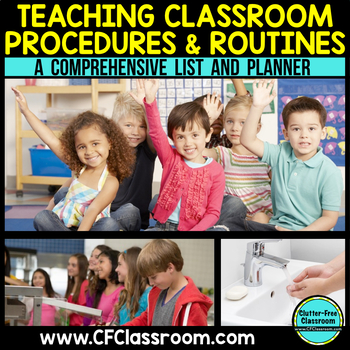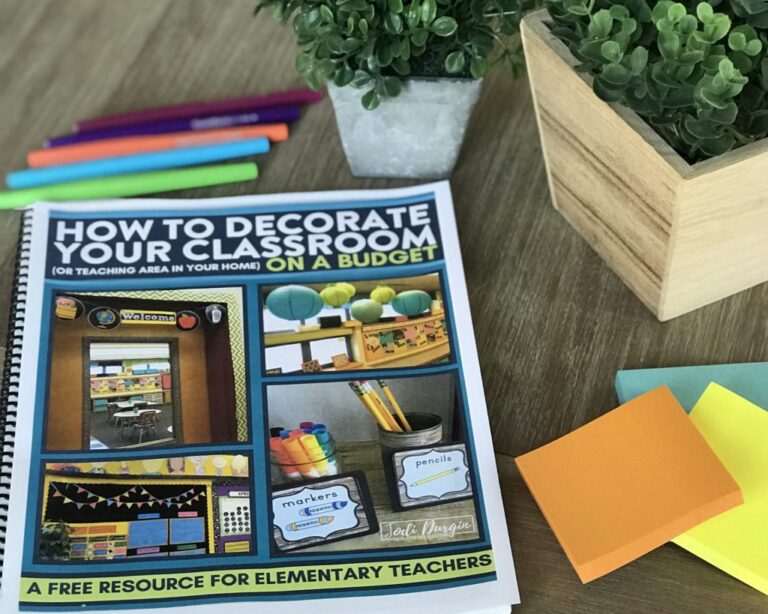I honestly feel strong classroom management is the most important thing teachers need to do in order to create the best, most-effective, learning environment that they possibly can. I love classroom organization. I adore classroom decor. But, if you don’t have a solid plan for how you will consistently run your classroom the rest is moot. Read below to snag some ideas for classroom procedures and routines that you can use in your classroom!

What are Classroom Procedures and Routines?
Classroom procedures and routines are the systematic ways that you and your students repeatedly complete daily, weekly, or monthly tasks. Having these is how the classroom runs efficiently and effectively.
Why are Procedures and Routines Important?
Being able to successfully manage a classroom comes down to two things: planning and consistency. You need to have very clear expectations and a solid foundation for how you want your room to run. That’s not to say you won’t make changes and tweak things along the way, but you need to go into the year having thought through each and every aspect of a school day. Below are 4 reasons why classroom procedures and routines are essential.
Creates an Effective Teaching Environment
A disorganized classroom without routines and expectations makes it difficult for the teacher to do her job. Students don’t know what to do, so they might get off task or cause disruptions. When the teacher is constantly redirecting students or handling behavior problems, she loses crucial teaching time. Classroom management strategies help create an organized classroom environment that’s conducive to teaching. Kids know the expectations in different types of learning situations. For example, kids would know that when working in small groups, they talk in quiet voices and take turns talking. They might each have a specific job within the group.
Maximizes Learning Time
Taking time before school starts to create routines and procedures saves you time in the long run. When the children know what to do, it becomes a natural part of the routine. After a few weeks, you don’t need to tell them what to do. The students know they get their planners out, write in homework assignments and gather all of their materials at the end of the day, for example. You can get your kids out the door faster at the end of the day. When you train them how to do each part of the school day, you don’t spend as much time giving directions.
Creates Consistency for Students
A teacher with strong classroom management skills creates consistency for his or her students. The kids know what to expect every day when it comes to the routine activities. Your students may fare better when you’re gone if you have set expectations for everyday tasks. They know how the classroom runs so they are able to help the substitute run the classroom. For example, if the kids know they’re supposed to enter the room and start working on a math problem on the board, a substitute doesn’t have to spend his time corralling the kids or trying to keep them occupied while everyone arrives.
You can also create consistency throughout the school by aligning your management strategies with the school-wide standards. If your school focuses on respect and responsibility, incorporate them into your classroom management techniques. The students will hear those words throughout the school and know that the expectations are the same anywhere in the building.
Decreases Behavior Issues
The main goal of classroom management is to reduce misbehavior in the classroom. Effective classroom management gives the students little time to misbehave. Because the expectations are clearly explained, the students know what they need to do. Transitions in particular are easier to control when a teacher has strong classroom management skills. For example, if you have dots on the floor for lining up and call one group at a time, the students know to listen for their groups and stand on a dot when called. Kids aren’t bunched up since the dots help space them out. They won’t rush and push if you only call a few students at a time. The expectations for behaviors that are part of a classroom management plan give students boundaries, as well as consequences.
How to Implement Classroom Procedures and Routines
Below are the steps for how to implement classroom procedures and routines in your classroom.
1. Download this Procedures and Routines Resource
You may be wondering, “How do I make sure I don’t miss any routines?” and “Is there a list I can find somewhere that has all of the routines I need to teach my students?” This procedures and routines resource includes a comprehensive list of all the procedures and routines you need to teach at the beginning of the school year so that your room runs smoothly. This resource is available in my Clutter-Free Classroom Teachers Pay Teachers store.
If you are wondering, “Do I really need it?” The answer is YES! Hundreds of teachers have shared that it has transformed their classroom and teaching life. This classroom procedures and routines packet includes over 150 routines and procedures so that you don’t overlook a single, itty bitty thing when planning for how your classroom will run. The packet will also provide you with a pacing calendar for pacing and teaching the routines, planning sheets to detail out how you envision each procedure in your classroom, 3 different styles of covers for your manual with matching stationary to print onto. It includes my tried and true method for teaching any and all procedures in just a few easy steps and details on how to create your manual.
2. Assemble Your Binder
After purchasing this resource, you can create a binder that houses every nitty, gritty detail for yourself and for your classroom aide if you have one. In order to do this, you’ll need to do the following:
- Read through the list of procedures.
- Highlight each procedure that you will use in your classroom.
- Add any additional procedures that are specific to your classroom and school.
- Write or type out the steps and expectations for each procedure. Be specific. Make note if you will need to gather props or create visuals for your lesson on teaching each procedure.
- Create a document titled, “Procedures and Routines” and list your steps for each procedure. Print out the document, place it in a binder and add a cover.
- Add a table of contents to make it easy for subs to access the information needed. I have a copy in my sub binder and reference the page number for each procedure when leaving sub plans. Provide a copy to classroom aides, parent volunteers, and students. Having everyone on the same page will be beneficial.
It may be helpful to cut and paste from that document to create a smaller manual for your students and their parents to access and an additional version that you leave with your substitute teacher plans. This is helpful because it results in all the players being on the same page, provides students a sense of security and safety because they know exactly what to expect and when to expect, and it establishes a framework to your day so that the classroom runs itself and zero time is wasted with the issues that arise from downtime and inconsistency.
3. Prioritize Your Procedures and Routines
You can’t teach all of the routines in the first day or even the first week. Decide which will be the most important to you and order them from there. It will be helpful to figure out which of the procedures and routines are most needed in order for your class to run effectively. If you can establish expectations for listening and creating order then the other items will be easier to teach. Write them into your plans.
4. Prepare Materials to Teach Each Procedure and Routine
Teaching routines and procedures is as important, if not more important, than any other lesson you’ll teach during the school year. Therefore, it is crucial that you plan for how you will present the details to the students. You may want to consider gathering props (i.e. paper towels and soap for modeling hand washing, a pencil and hand held sharpener for pencil routines, etc). You’ll also need to prepare visual cues like charts or procedure books. If you teach a primary grade, it would be best to use photos or clipart.
5. Execute a Lesson Explaining the Expectations
Explain the reason for the routine and the expectations that you have for it. It is most effective to have the routine displayed visually so that it can be referenced as you practice. While all students will benefit from visual cues, it is imperative that they are included for younger learners who have not yet learned to read. Here are some quick tips:
- Photos are a great tool. Keep the directions simple and concrete, while detailing exactly what is expected of them.
- If you have created a classroom procedures manual, simply enlarge each page on a photocopier to create an easy to see chart. It’s helpful to project the expectation from your computer as well.
- In the future, you may even consider making a video of your class performing the procedures at the end of the school year as a “training video” for your new class.
- Model the procedure yourself. Talk through your actions so they can see what you want them to do, where you want them to do it and how you want them to do it.
6. Practice the Procedures and Routines
After explaining and modeling the routine, you’ll need to allow time for the students to practice. Begin by referencing the visual chart again and reading through each step. Next, walk the class through the routine and provide positive feedback as it applies. Upon completion, either state what was done correctly or else explain how they could improve.
7. Review and Provide Feedback on an Ongoing Basis
Within a few weeks, the students’ actions will become automatic. In the meantime, it’s important to continue to review and practice the routines as they occur.
In closing, we hope you found this post about classroom procedures and routines helpful! If you did, then you may also be interested in these posts:
- First Day of School Read Aloud Books for Elementary Teachers
- Classroom Morning Routine Ideas for Elementary Teachers
- Back to School Binder Ideas for Teachers






